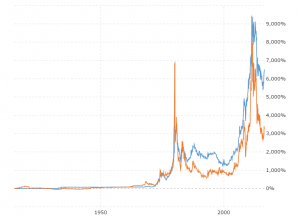European Gold Coins
In an environment of continuing unrest and uncertainty, gold is likely to hold or increase in value for some time yet. Keeping gold as an asset makes sense, but for coin collectors, there needs to be more interest than just hunks of the stuff in your safe. This is where looking further afield can mean you still buy gold, but in the form of interesting coins that have collecting value too.
The traditional American Eagle and Canadian Maple Leaf bullion coins are overwhelmingly popular, and they can still form the core of your assets, but adding something from outside our borders is going to make life much more interesting. Turning to Europe, and its rich coin heritage make a lot of sense, so let’s look at some readily-available gold coins of European origin, which will add interest and variety to your collection.
Austrian Gold
The Austro-Hungarian Empire ruled a large part of Europe from 1867 to 1918. It consisted of present-day Austria, Hungary, Slovakia and Croatia. It was a major power, rivalling America, Britain and Germany in its military and economic strength. The Emperor Franz Joseph I, King of Austria, was head of the empire from its beginning to his death in 1916. The Empire was broken-up after its defeat in World War I. The coinage was the romantic-sounding Ducat, which had been around for centuries, and was used in national versions across much of Europe. Austro-Hungarian gold ducats were worth around $4 in Franz Joseph’s time, but of course then a dollar went a long way! Most Austrian ducats available today show the Emperor’s bust portrait on the obverse, and the coat-of-arms of the Empire on the reverse, and they may be dated in any of the years of his reign. A common date is 1915, as this coin was re-struck in large quantities in 1916 to commemorate the Emperor’s death. As well as ducats, Austrian coins can be found in corona denominations, usually 100, 20 or 10, with 10 coronas roughly equaling one ducat.
Gold French Francs
French franc coins in gold can still be found, often in 20-franc denominations. France went through many changes in the 19th century, so a variety of obverse busts, with different date periods, can be found. Napoleon III, the nephew of the much more famous Napoleon Bonaparte, ruled from 1852 to 1870, and coins dated in those years will show the head of Napoleon III.
Another French gold coin is the 20-franc 1899 – 1914 coin, with ‘Marianne’, the symbol of France on the obverse, and the French Rooster, another symbol of the nation, on the reverse. By this time the Third Republic had ended the monarchy, so the famous French slogan, LIBERTE EGALITE FRATERNITE (freedom, equality, brotherhood) surrounds the rooster, while REPUBLIQUE FRANÇAISE is on the obverse. A history of the turbulent years in France could be assembled with different 20-franc coins from the period.
Swiss Francs
Switzerland has always been connected with security and bank safety, and that continues even today. Gold franc coins were stamped between 1897 and 1936, when gold ceased to be legal tender. Additional commemorative coins were struck in 1947 and 1949. These coins show the coat-of-arms of Switzerland on the reverse, along with the striking date, the value in francs, and the symbol, FR, for francs. The obverse has the profile of a woman with braided hair, designed by Fritz Ulysse Landry. The word, HELVITIA is engraved above her head, and she is the female personification of the Swiss Confederation (called Confœderatio Helvetica).








